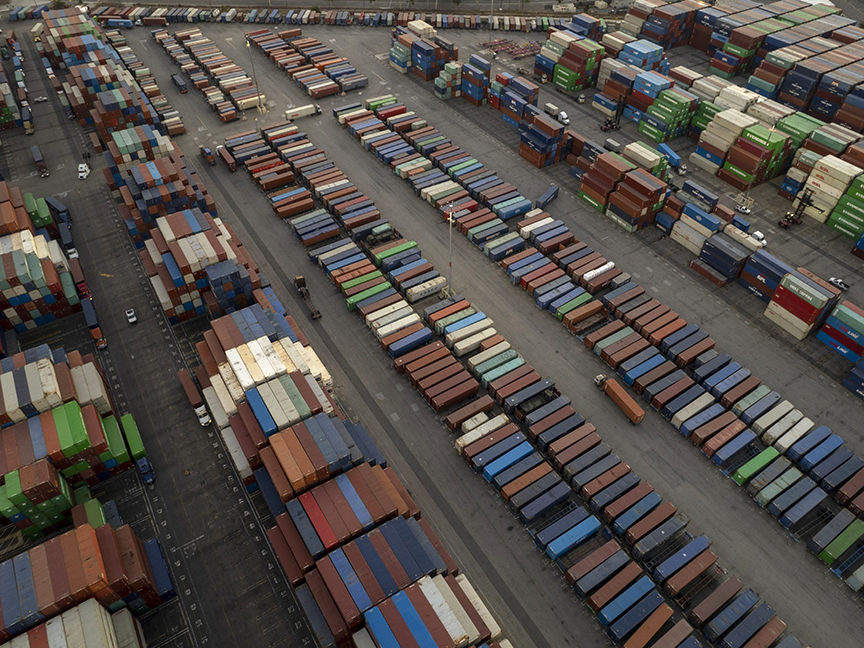
Visit Our Sponsors |
|
|
|
|
|
|
|
|
|
|
|
|
|
|
|
|
|
|
|
|
|
|
|
|
|
|
|
|
|
|
|
|
|
|
|
|
|
|

The bottlenecked ports in Los Angeles face a narrow window between now and midyear to clear container backlogs before another import surge and union-contract talks threaten to stall progress moving record volumes of cargo through the busiest U.S. gateway for trade.
There are good operational reasons for optimism that L.A. and Long Beach will catch enough of a breather in the next four months. The number of inbound ships has fallen by about one-third since hitting an early-January peak of 109, stacks of long-dwelling containers are shrinking and omicron cases among dockworkers are fading.
There’s also scope for caution, given the economic tide the ports are swimming against. Consumers have shrugged off inflation so far and kept spending. Companies are still ordering more and earlier than usual, turning the past 18 months into one long peak season for shipping. Another incentive to stock up: a potentially disruptive contract renewal for West Coast longshoremen.
“It’s these surges in demand that create the challenge,” said Julie Gerdeman, CEO of supply chain risk analytics firm Everstream Analytics. She called it a dance between “just in time” and “just in case” inventory management brought on by the pandemic that’s rewiring global trade.
On the front lines are the union workers who load and unload dozens of ships every week in Southern California. Though negotiations are expected to start as soon as next month, the current six-year contract between the International Longshore and Warehouse Union and their employers, represented by the Pacific Maritime Association, expires July 1.
It could get contentious and stakeholders at every link in the supply chain are taking notice.
In the last round of contract talks that began in 2014, disagreements dragged on for nine months, creating an economic headwind across the country, a long line of waiting vessels and shortages for some consumer goods. According to an analysis by Copenhagen-based Sea-Intelligence, it took the shipping industry eight to nine months after a deal was reached in February 2015 to return to normal service.
Now flush with cash, shipping lines want to invest in productivity enhancements at their terminals — like software, artificial intelligence and autonomous equipment that often replace people. With labor scarce nationwide, issues such as automation, pay and benefits could be more contentious than ever to work out. Add to that the relatively pro-labor stance of the Biden administration and the record profits of foreign-owned shipping companies, and the leverage could tip toward the union.
‘Don’t Get Caught’
Retailers want to make sure they don’t get caught up in delays again, said Jonathan Gold, the National Retail Federation’s vice president for supply chain and customs policy. “So they’re going to start to shift and mitigate the risk of potential slowdown disruptions,” he said.
Walmart Inc., reporting a positive outlook for business this year, showed last week that big retailers are able to navigate scarce transportation capacity, higher wages and rising fuel costs. Meanwhile, Bed Bath & Beyond Inc. said it increased some prices and adjusted its discount strategy due to “pervasive freight and supply chain headwinds.”
This year some purchasing managers are already ordering goods early to try to get ahead of the contract expiration, and by considering routes through ports on the Gulf Coast or East Coast, or even air freight where possible. Ports in Houston and Charleston, South Carolina, have also been overrun with container ships in recent weeks so options are limited.
Gerdeman said her customers are monitoring choke points and risks that could impact their ability to get products to market. They’re ordering safety or buffer stockpiles ahead of the next peak, or considering diverting to ports in other regions or other modes altogether. “We have customers that, even in the face of profitability hits, are making decisions to build up inventory.”
Gene Seroka, executive director of L.A.’s port, sees retailers spending in the second quarter to restock the lowest inventories in a decade. He said stores that stocked up earlier than usual last year were rewarded with solid holiday sales — a pattern that might happen again this year. “We have to make up ground now and be prepared for that summer peak,” he said last week at an event announcing L.A.’s strongest January volume on record.
Seroka is urging steps to boost trucking and rail capacity so containers don’t sit dockside for long.
Brent Hutto, Truckstop.com’s chief relationship officer, said it’ll be a while before the excessive pressure on the various modes of freight transportation gets worked out. “It’s likely going to be the end of this year, the beginning of next year for all freight to come out of this overflow,” Hutto said.
Still, some factors are out of port operators’ control and have more to do with the broader health of American consumers. Flexport Inc. Chief Economist Phil Levy is tracking the personal consumption expenditures on goods versus services as a gauge of “normal.”
“For a number of years prior to the pandemic, this is a really flat boring graph and it stayed almost constant,” Levy said. “And then in the pandemic, this just shot up.”
The latest reading of Flexport’s Post-Covid Indicator showed American consumers’ preference for goods over services will continue at close to summer 2020 levels throughout the first quarter. And while the PCI showed the ratio of consumer goods versus total spending dipped in December to 99% of pre-pandemic levels, the new reading estimated it at 106% for January.
Such strong demand only makes the ports’ efforts tougher. A separate Flexport index showed cargo is still spending close to record amounts of time — more than 100 days — in transit to the U.S. and Europe from Asia.
RELATED CONTENT
RELATED VIDEOS
Timely, incisive articles delivered directly to your inbox.

